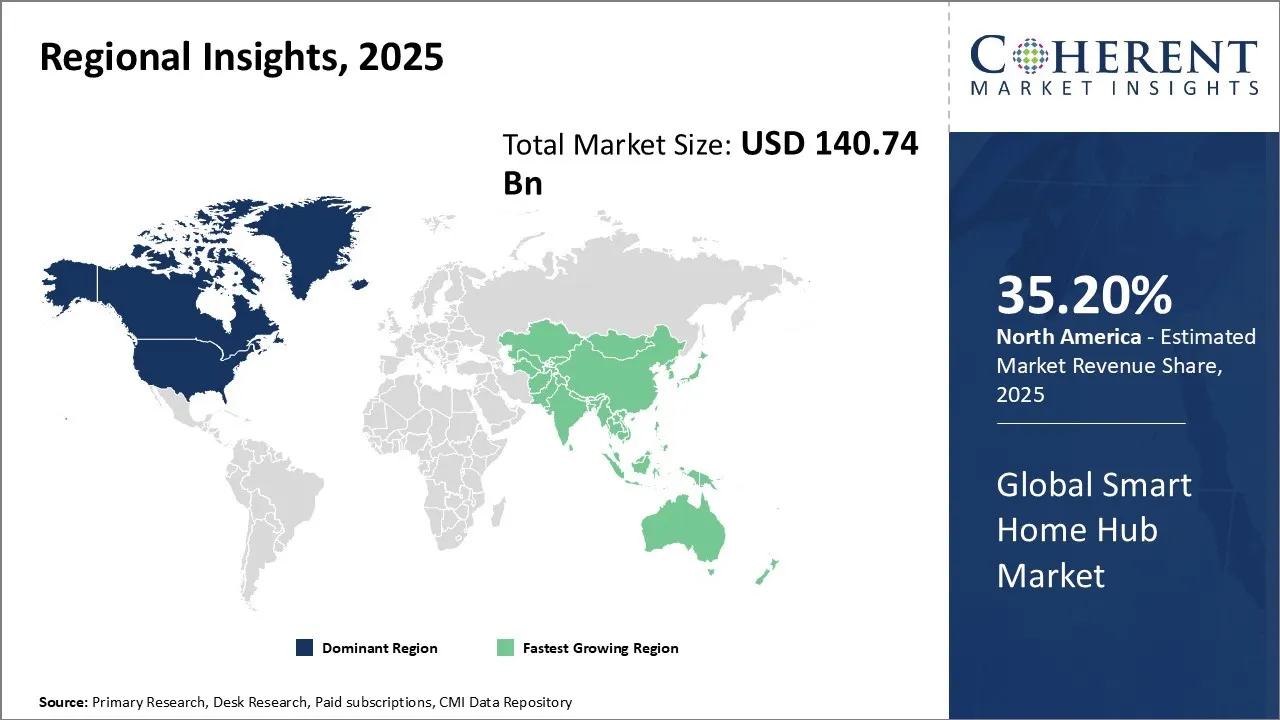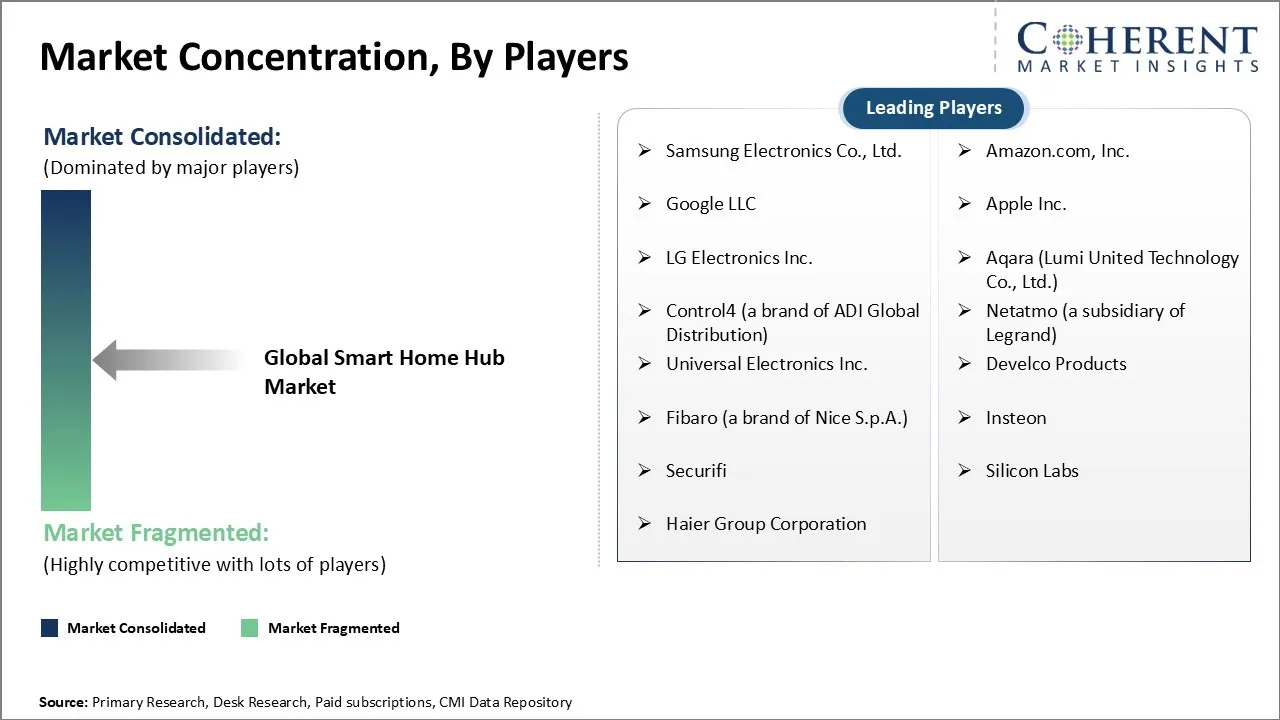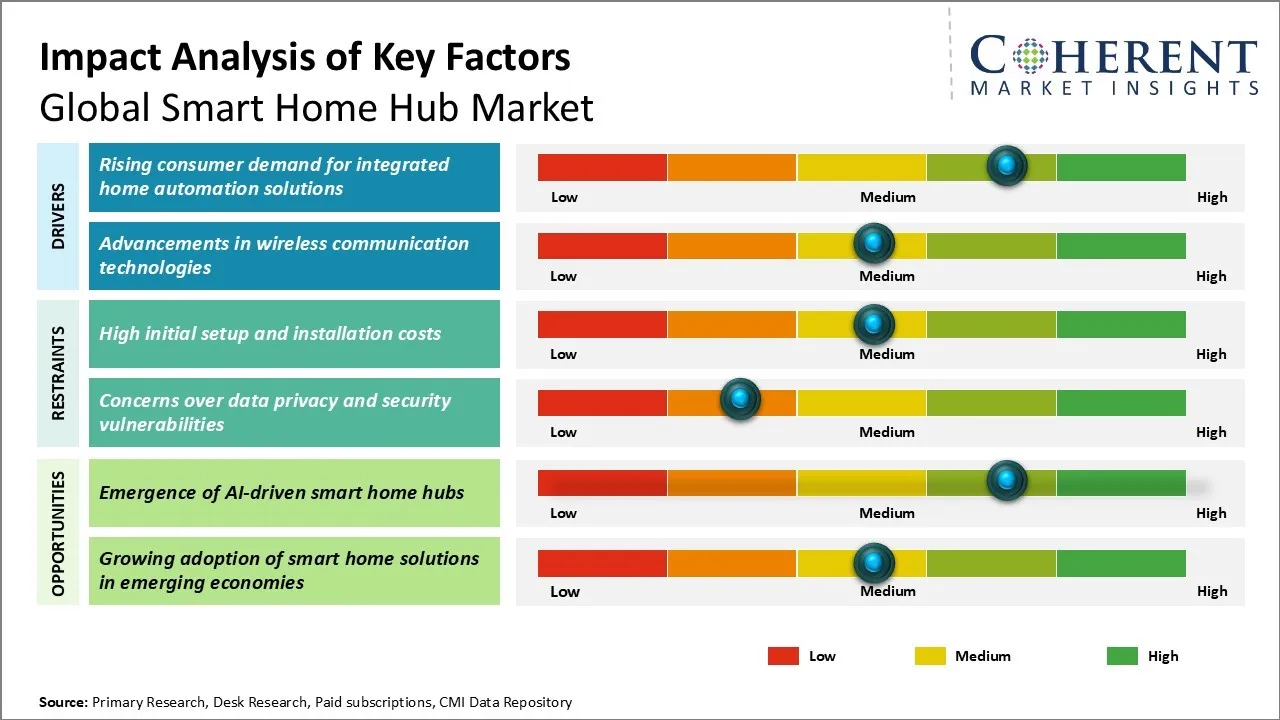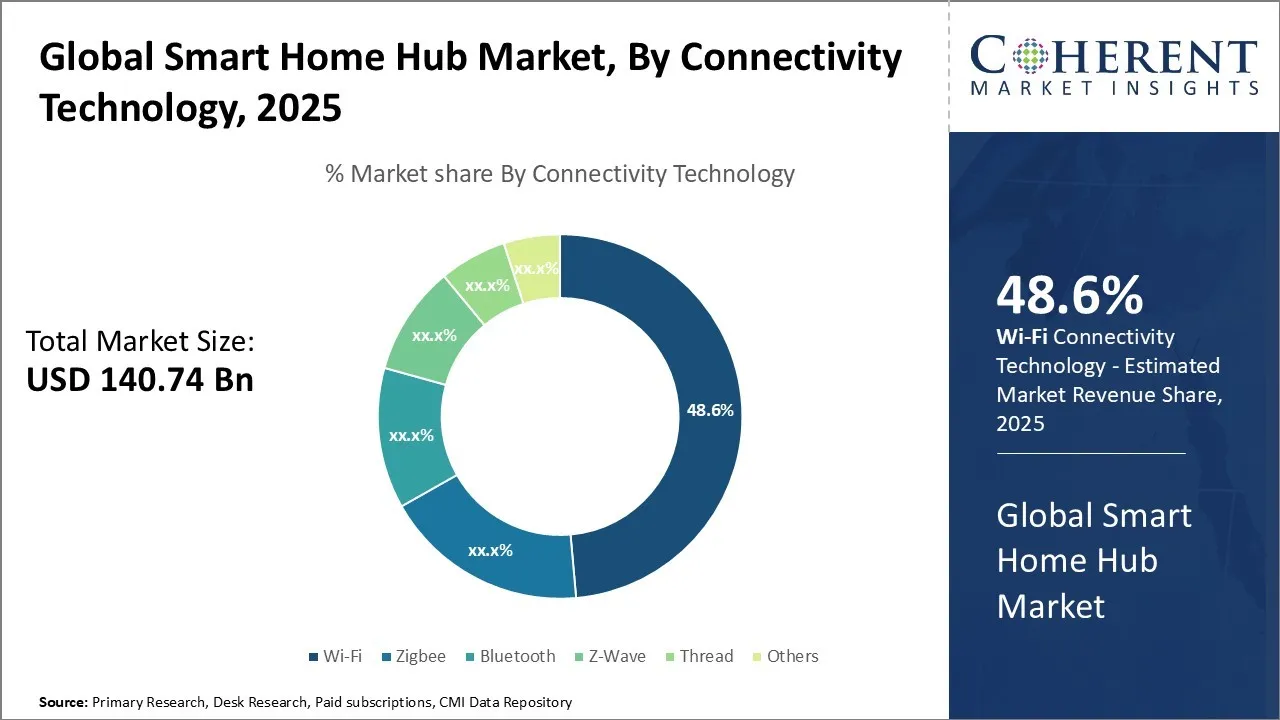Global Smart Home Hub Market Size and Forecast – 2025-2032
The Global Smart Home Hub Market is estimated to be valued at USD 140.74 Bn in 2025 and is expected to reach USD 320.99 Bn by 2032, exhibiting a compound annual growth rate (CAGR) of 12.5% from 2025 to 2032.
Key Takeaways of the Global Smart Home Hub Market:
- The Wi-Fi segment is expected to lead the market holding a share of 48.6% in 2025.
- The home security & automation segment is projected to dominate with a share of 41.3% in 2025.
- The fixed segment is estimated to lead the market with a share of 53.4% in 2025.
- North America is estimated to lead the market with a share of 35.2% in 2025. Asia Pacific, holding a share of 28.5% in 2025, is projected to be the fastest growing region.
Market Overview:
The smart home hub market is seeing the integration of artificial intelligence and machine learning technologies, which offer more personalized user experiences. Also, the increasing connectivity between different smart home devices and platforms is driving the market growth, as consumers seek seamless connectivity and control over their smart home ecosystems.
Current Events and their Impact
|
Current Events |
Description and its impact |
|
Technological Standardization & Interoperability |
|
|
Regulatory Shifts (Europe) |
|
Uncover macros and micros vetted on 75+ parameters: Get instant access to report
Global Smart Home Hub Market by Connectivity Technology – Wi-Fi leads due to its ubiquity and ease of integration
Wi-Fi has emerged as the dominant connectivity technology in the global smart home hub market, capturing the largest market share of 48.6% in 2025. A vast majority of homes already equipped with Wi-Fi routers. This existing infrastructure makes it easier for smart home hub manufacturers to integrate Wi-Fi connectivity into their devices. To add to this, Wi-Fi is a well-established and mature technology, having many compatible devices available in the market. Manufacturers can easily incorporate Wi-Fi modules into their products with seamless connectivity with other smart home devices such as smartphones, tablets, and voice assistants.
Also, Wi-Fi offers high-speed and reliable connectivity, which makes smooth operation possible. With the increasing demand for real-time data transmission and low latency, Wi-Fi's ability to deliver fast and stable connections has made it the preferred choice for many smart home applications. The latest advancements in Wi-Fi technology, such as Wi-Fi 6 (802.11ax), have further enhanced its performance, providing even faster speeds and improved network capacity.
Global Smart Home Hub Market by Application – Home Security & Automation leads due to increasing consumer awareness and demand for enhanced safety and convenience
The home security & automation segment has emerged as the leading application, capturing the highest market share of 41.3% in 2025. The awareness about home security is increasing among consumers with the rise in crime rates. Smart home hubs, equipped with advanced security features such as motion sensors, video surveillance, and smart locks, are thus seeing increased demand.
To add to this, the convenience and flexibility offered by home automation have added to the demand for smart home hubs. These hubs let users control and monitor different aspects of their homes remotely, such as lighting, temperature, and appliances, through a single centralized platform. This greatly improves user experience, making smart home hubs an essential component of modern home automation systems.
The Role of Artificial Intelligence (AI) in the Market
AI is revolutionizing the smart home hub market by enhancing automation, personalization, and security. With the integration of Natural Language Processing (NLP), AI-powered voice assistants like Amazon Alexa and Google Assistant allow users to control their entire home ecosystem using natural speech, making it more intuitive. Additionally, predictive automation enables hubs to learn user behaviors and adjust settings automatically, optimizing convenience, energy efficiency, and comfort. For instance, Amazon Echo learns routines, adjusting temperature and lighting before users even ask, providing a seamless experience.
AI also plays a critical role in smart security, enabling real-time threat detection through AI-driven cameras and sensors. These systems can recognize faces, identify unusual activity, and even alert users or authorities if necessary. Google Nest Hub, for example, uses AI to offer personalized home monitoring and integrate with various smart devices for automated responses.
Regional Insights

To learn more about this report, Download Free Sample
North America Smart Home Hub Market Analysis and Trends
North America, holding a share of 35.2% in 2025, dominates the global smart home hub market. The region has a well-established technology ecosystem, with a high adoption rate of smart home devices among consumers. The presence of major technology companies, such as Amazon, Google, and Apple, which offer smart home hub products, has significantly contributed to the market growth. These companies have invested heavily in research and development, continuously innovating and introducing new features to their smart home hub offerings. Additionally, the region's robust infrastructure, including high-speed internet connectivity and widespread Wi-Fi availability, has facilitated the seamless integration of smart home hubs into households.
Asia Pacific Smart Home Hub Market Analysis and Trends
The Asia Pacific region, holding a share of 28.5% in 2025, is expected to exhibit the fastest growth in the global smart home hub market. The rapid urbanization, rising disposable incomes, and increasing awareness about smart home technologies have been key drivers of growth in this region. Countries such as China, Japan, and South Korea have witnessed a significant uptake of smart home devices, including hubs, as consumers seek convenience, energy efficiency, and enhanced home security. The region's large population base and the increasing middle-class population have created a vast market opportunity for smart home hub manufacturers. The presence of local technology companies in the region, such as Xiaomi, have also contributed to the market's growth, as they offer innovative and affordable smart home solutions tailored to the specific needs of consumers in the Asia Pacific region.
Global Smart Home Hub Market Outlook for Key Countries:
U.S. Smart Home Hub Market Analysis and Trends
The U.S. smart home hub market is highly advanced and competitive. Major players like Amazon, with its Echo series, and Google, with its Google Home devices, have a strong presence in the market. These companies have been continuously innovating and adding new features to their smart home hub offerings, driving consumer adoption.
The country's tech-savvy population, coupled with the availability of a wide range of smart home devices compatible with these hubs, has further fueled market growth. Additionally, the increasing focus on energy efficiency and home automation has led to the integration of smart home hubs with various household appliances and systems such as lighting, heating, and security.
China Smart Home Hub Market Analysis and Trends
China's large population, increasing disposable income, and rapid urbanization have created a substantial demand for smart home technologies. Local companies, such as Xiaomi and Baidu, have introduced their own smart home hub products, catering to the specific needs and preferences of Chinese consumers. The government's push towards smart city development and the Internet of Things (IoT) has also played a crucial role in driving the adoption of smart home hubs.
U.K. Smart Home Hub Market Analysis and Trends
The U.K. has a tech-savvy population and high adoption rate of smart home devices, which creates demand for smart home hubs. Major players like Amazon and Google have a strong presence in the market, offering their popular smart home hub products. British consumers have shown a interest in integrating smart home hubs with different household appliances and systems, such as heating, lighting, and security.
Germany Smart Home Hub Market Analysis and Trends
Germany is characterized by a strong focus on innovation and quality. The country's consumers have a high appreciation for advanced technology and are willing to invest in premium smart home solutions. Germany-based companies, such as Bosch and Siemens, are developing smart home technologies including hubs.
Market Players, Key Development, and Competitive Intelligence

To learn more about this report, Download Free Sample
Key Developments:
- In March 2024, SmartThings, Samsung’s global connected living platform, announced its expanded partnership with Philips Hue, global leader in smart lighting, aimed at revolutionizing how users interact with their home entertainment systems. This collaboration introduces a series of exclusive updates and greater control of the Philips Hue Sync TV App through SmartThings, designed to elevate home automation and enhance control of light sync.
- In May 2024, Aqara, a provider of smart home products, announced the global availability of its next-generation Matter hub, the Hub M3.
- In July 2024, LG Electronics (LG), a consumer electronics provider, acquired an 80 percent stake in Athom, an industry-leading smart home platform company based in Enschede, Netherlands. The agreement included plans to acquire the remaining 20 percent within the next three years. This strategic move aims to enhance LG’s connectivity within open smart home ecosystems.
- In December 2024, Homey, a provider of smart home solutions, introduced the Pro Mini, a compact, affordable version of its USD 400 flagship Pro hub. Priced at USD 199, it offers the same powerful Homey OS for managing diverse smart devices.
Top Strategies Followed by Global Smart Home Hub Market Players
- Established players are focusing on innovating cutting-edge technologies, such as advanced voice assistants, seamless device integration, and enhanced security features, to differentiate themselves in the market.
- Amazon is continuously pushing the boundaries of innovation with its Echo Hub, featuring an advanced version of Alexa, deep integration with Matter and Zigbee, and robust privacy and security controls.
- Mid-level players are delivering cost-effective solutions to attract price-sensitive consumers by optimizing their production processes and leveraging economies of scale.
- TP-Link targets budget-conscious consumers with its Tapo H100, a compact, affordable smart hub offering essential automation, alarm functions, and multi-device compatibility.
- Small-scale players are focusing on specific market segments or developing products with distinct features to cater to the unique needs and preferences of their target customers.
- Hubitat appeals to tech-savvy users seeking local automation and privacy. Unlike cloud-dependent hubs, the Hubitat Elevation runs all automations locally, offering faster response times and greater data security. Its niche focus on offline functionality and advanced rule-building attracts users concerned about cloud reliance and data privacy.
Market Report Scope
Smart Home Hub Market Report Coverage
| Report Coverage | Details | ||
|---|---|---|---|
| Base Year: | 2024 | Market Size in 2025: | USD 140.74 Bn |
| Historical Data for: | 2020 To 2024 | Forecast Period: | 2025 To 2032 |
| Forecast Period 2025 to 2032 CAGR: | 12.5% | 2032 Value Projection: | USD 320.99 Bn |
| Geographies covered: |
|
||
| Segments covered: |
|
||
| Companies covered: |
Samsung Electronics Co., Ltd., Amazon.com, Inc., Google LLC, Apple Inc., LG Electronics Inc., Aqara (Lumi United Technology Co., Ltd.), Control4 (a brand of ADI Global Distribution), Netatmo (a subsidiary of Legrand), Universal Electronics Inc., Develco Products, Fibaro (a brand of Nice S.p.A.), Insteon, Securifi, Silicon Labs, and Haier Group Corporation |
||
| Growth Drivers: |
|
||
| Restraints & Challenges: |
|
||
Uncover macros and micros vetted on 75+ parameters: Get instant access to report
Market Dynamics

To learn more about this report, Download Free Sample
Global Smart Home Hub Market Driver - Rising consumer demand for integrated home automation solutions
The global smart home hub market is experiencing significant growth due to the rising consumer demand for integrated home automation solutions. As technology advances and becomes more accessible, homeowners are increasingly seeking ways to simplify their lives and enhance their living experiences through seamless connectivity and control of their smart home devices. Smart home hubs serve as the central point of control, enabling users to manage and monitor various connected devices, such as lighting systems, thermostats, security cameras, and appliances, from a single platform.
Samsung’s SmartThings Hub allows users to control a wide range of smart devices—lights, thermostats, door locks, cameras, and appliances—from a single app. Its compatibility with Zigbee, Z-Wave, and Matter makes it a versatile platform.
Global Smart Home Hub Market Opportunity: Emergence of AI-driven smart home hubs
The emergence of AI-driven smart home hubs presents a significant opportunity for the global smart home hub market. With the rapid advancements in artificial intelligence and machine learning technologies, smart home hubs are becoming increasingly sophisticated and intuitive. AI-powered hubs can learn from user behavior patterns, preferences, and routines, enabling them to provide personalized and context-aware automation services.
The Google Nest Hub (2nd Gen) is a prime example of the shift toward AI-powered smart hubs. With features like sleep sensing, on-device machine learning, and context-aware Google Assistant responses, it adapts to user behavior over time. The hub can predict routines, offer proactive reminders, and intelligently manage connected devices based on usage patterns.
Analyst Opinion (Expert Opinion)
- Despite the advent of standards like Matter, many smart home hubs still struggle with seamless integration across brands and ecosystems. Consumers often need multiple hubs or complex workarounds to connect devices from different manufacturers. There’s a clear gap for a truly universal, plug-and-play hub that offers intuitive cross-brand compatibility without sacrificing performance or security.
- The market skews heavily toward either high-end hubs with complex features or budget hubs with limited capabilities. The mid-tier segment—tech-savvy but budget-conscious consumers—lacks options that combine affordability with robust automation, security, and AI integration.
- Vendors tend to design products for North American or Western European households, overlooking regional electrical standards, internet bandwidth limitations, and language interfaces in Africa, Southeast Asia, and Latin America. There’s a significant product-market fit issue in these fast-growing regions.
Market Segmentation
- Connectivity Technology Insights (Revenue, USD Bn, 2020 - 2032)
-
- Wi-Fi
- Zigbee
- Bluetooth
- Z-Wave
- Thread
- Others
- Application Insights (Revenue, USD Bn, 2020 - 2032)
-
- Home Security & Automation
- Entertainment & Media
- Energy Management
- Lighting Control
- Others
- Regional Insights (Revenue, USD Bn, 2020 - 2032)
-
- North America
- U.S.
- Canada
- Latin America
- Brazil
- Argentina
- Mexico
- Rest of Latin America
- Europe
- Germany
- U.K.
- Spain
- France
- Italy
- Russia
- Rest of Europe
- Asia Pacific
- China
- India
- Japan
- Australia
- South Korea
- ASEAN
- Rest of Asia Pacific
- Middle East
- GCC Countries
- Israel
- Rest of Middle East
- Africa
- South Africa
- North Africa
- Central Africa
- North America
- Key Players Insights
-
- Samsung Electronics Co., Ltd.
- Amazon.com, Inc.
- Google LLC
- Apple Inc.
- LG Electronics Inc.
- Aqara (Lumi United Technology Co., Ltd.)
- Control4 (a brand of ADI Global Distribution)
- Netatmo (a subsidiary of Legrand)
- Universal Electronics Inc.
- Develco Products
- Fibaro (a brand of Nice S.p.A.)
- Insteon
- Securifi
- Silicon Labs
- Haier Group Corporation
Sources
Stakeholders:
- Smart Home Device Manufacturers (e.g., Hardware Engineers, Product Managers)
- Home Automation Installers & Service Providers (e.g., Certified Smart Home Technicians)
- Consumer Electronics Retailers (e.g., Sales Directors, Regional Managers)
- Telecom and Internet Service Providers involved in IoT integration
- Residential Property Developers integrating smart technologies
- Cybersecurity Consultants specialized in IoT environments
Databases:
- U.S. Bureau of Economic Analysis
- International Telecommunications Union (ITU)
- Home Automation Global Index
- World Economic Forum – Connected Devices Tracker
Magazines:
- Smart Home Trends Monthly
- Connected Living Magazine
- Home Automation Review Digest
- Smart Tech Today
- Digital Habitat Weekly
Journals:
- Journal of Internet of Things and Smart Environments
- Smart Systems and Applications Journal
- Home Intelligence Systems Review
- Journal of Consumer Electronics Innovation
- IoT Security & Standards Journal
Newspapers:
- Smart Tech Chronicle
- IoT Business Daily
- The Global Tech Post
- SmartHome News Network (SHNN)
- The Innovation Times
Associations:
- Global Smart Home Alliance (GSHA)
- IoT Device Manufacturers Association (IDMA)
- Home Automation Industry Consortium (HAIC)
- International Alliance for Connected Living (IACL)
- Consumer Tech & Innovation Council (CTIC)
Public Domain Sources:
- U.S. Census Bureau
- EUROSTAT
- United Nations Economic Commission for Europe (UNECE)
- World Bank
- ResearchGate
Proprietary Elements:
- CMI Data Analytics Tool, Proprietary CMI Existing Repository of information for last 8 years
Share
Share
About Author
As an accomplished Senior Consultant with 7+ years of experience, Pooja Tayade has a proven track record in devising and implementing data and strategy consulting across various industries. She specializes in market research, competitive analysis, primary insights, and market estimation. She excels in strategic advisory, delivering data-driven insights to help clients navigate market complexities, optimize entry strategies, and achieve sustainable growth.
Missing comfort of reading report in your local language? Find your preferred language :
Transform your Strategy with Exclusive Trending Reports :
Frequently Asked Questions
EXISTING CLIENTELE
Joining thousands of companies around the world committed to making the Excellent Business Solutions.
View All Our Clients


